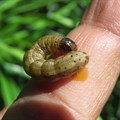African countries should turn to lower risk solutions to fight fall armyworm

The fall armyworm was previously found only in the Americas. But in 2016 it appeared in West Africa and is now found in over 40 countries in tropical and southern Africa. It has also recently been reported in India. Research mapping environmental suitability shows that large areas of Asia are highly suitable for fall armyworm. This includes parts of India and China, the world’s second largest producer of maize.
The pest presents a threat to food security and its impact on maize alone could devastate the livelihoods of tens of millions of affected farmers. Recent estimates suggest that the potential yield loss due to fall armyworm in 12 major African maize producing countries would be huge. The data show that between 4 million and 18 million tons annually out of a total expected production of 39 million tonnes could be lost. The economic cost is estimated to be US$1–4.6 billion per year.
To protect their food supplies, affected countries in Africa are putting in place large-scale emergency measures to control fall armyworm. Many of these focus on the widespread distribution and use of pesticides. But this isn’t the ideal solution for a number of reasons. Firstly, some pesticides are harmful and highly toxic. Secondly, pesticides put many smallholder farmers at risk – many aren’t familiar with the products and may lack the protective equipment to prepare and apply them safely.
There are other lower risk alternatives. One of these is biopesticides – naturally occurring substances or organisms that kill pests. In a recently published study we show that biopesticides present safe, low risk options for controlling fall armyworm which can serve as viable alternatives to some of the conventional pesticides currently available or in use in Africa, many of which are highly hazardous.
Biopesticide products to control fall armyworm are already commercially available in the Americas and are regularly used by farmers in North and South America. Some African countries are also moving in this direction. For example, South Africa has already provisionally registered several biopesticide products for use against the fall armyworm, and biopesticide trials are underway in many other countries.
What we found
Our study assessed more than 50 biopesticide active ingredients which have been registered in fall armyworm’s native range in the Americas as well as in some African countries. In our assessments of each biopesticide, we reviewed the literature and regulatory documents with the aim of answering five key questions: Is the biopesticide effective against fall armyworm? Is the biopesticide of low risk to human health and the environment? Is it sustainable? Is it practical for use by smallholder farmers? Is the biopesticide available? We recommended follow-up action for biopesticides which passed these key criteria.
Through our research, we identified 23 active ingredients that we recommended for further consideration. We also identified eight active ingredients that should be brought to market immediately. These include products containing neem plant extracts and Bacillus thuringiensis, two of the most widely used biopesticides globally. This includes fast-tracking product registration, as well as reviewing and updating information materials and recommendations for farmers, as well as taking into account product availability.
But much more needs to be done if biopesticides are going to replace chemical pesticides. For example, in the medium-term governments will have to assist farmers by subsidising biopesticides, an approach already being adopted by Ghana.
Governments could also consider local production of biopesticides, working in partnership with private sector companies.
Challenges
There are a host of challenges too. Few biopesticide products are currently registered for use in African countries. And most of those registered aren’t yet widely available or affordable, particularly for smallholder farmers. While some farmers might be willing to pay a premium for a lower risk product, many smallholders have such small margins that they will seek to minimize production costs. So older, off-patent and cheaper pesticides may be preferred, despite their inherent dangers.
With greater support from governments, research, the private sector and NGOs, a market for lower risk products could be developed, which would lower prices. Ultimately, biopesticides present an opportunity to lower not just the economic cost of controlling fall armyworm in Africa, but also the cost to the environment and human health.
Such an approach should fit into a broader drive to control fall armyworm by using a much more integrated approach that combines a variety of agricultural practices. Known as integrated crop management, this approach involves combining a range of practices with an emphasis on those regarded as “low risk” compared to conventional chemical pesticides. This could include closely monitoring the crop, intercropping, manual removal, biological control, insect-resistant varieties and traditional methods such as applying ash.
Roger Day, programme executive at CABI, also contributed to this article.
This article is republished from The Conversation under a Creative Commons license. Read the original article.
Source: The Conversation Africa

The Conversation Africa is an independent source of news and views from the academic and research community. Its aim is to promote better understanding of current affairs and complex issues, and allow for a better quality of public discourse and conversation.
Go to: https://theconversation.com/africa
























